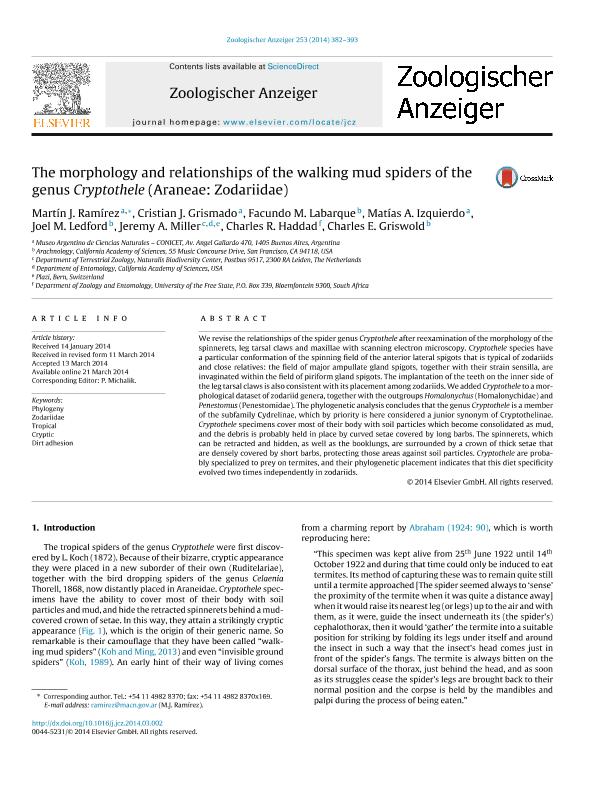Artículo
The morphology and relationships of the walking mud spiders of the genus Cryptothele (Araneae: Zodariidae)
Ramirez, Martin Javier ; Grismado, Cristian José
; Grismado, Cristian José ; Labarque, Facundo Martín
; Labarque, Facundo Martín ; Izquierdo, Matías Andres
; Izquierdo, Matías Andres ; Ledford, Joel M.; Miller, Jeremy A.; Haddad, Charles R.; Griswold, Charles E.
; Ledford, Joel M.; Miller, Jeremy A.; Haddad, Charles R.; Griswold, Charles E.
 ; Grismado, Cristian José
; Grismado, Cristian José ; Labarque, Facundo Martín
; Labarque, Facundo Martín ; Izquierdo, Matías Andres
; Izquierdo, Matías Andres ; Ledford, Joel M.; Miller, Jeremy A.; Haddad, Charles R.; Griswold, Charles E.
; Ledford, Joel M.; Miller, Jeremy A.; Haddad, Charles R.; Griswold, Charles E.
Fecha de publicación:
03/2014
Editorial:
Elsevier Gmbh
Revista:
Zoologischer Anzeiger
ISSN:
0044-5231
Idioma:
Inglés
Tipo de recurso:
Artículo publicado
Clasificación temática:
Resumen
We revise the relationships of the spider genus Cryptothele after reexamination of the morphology of the spinnerets, leg tarsal claws and maxillae with scanning electron microscopy. Cryptothele species have a particular conformation of the spinning field of the anterior lateral spigots that is typical of zodariids and close relatives: the field of major ampullate gland spigots, together with their strain sensilla, are invaginated within the field of piriform gland spigots. The implantation of the teeth on the inner side of the leg tarsal claws is also consistent with its placement among zodariids. We added Cryptothele to a morphological dataset of zodariid genera, together with the outgroups Homalonychus (Homalonychidae) and Penestomus (Penestomidae). The phylogenetic analysis concludes that the genus Cryptothele is a member of the subfamily Cydrelinae, which by priority is here considered a junior synonym of Cryptothelinae. Cryptothele specimens cover most of their body with soil particles which become consolidated as mud, and the debris is probably held in place by curved setae covered by long barbs. The spinnerets, which can be retracted and hidden, as well as the booklungs, are surrounded by a crown of thick setae that are densely covered by short barbs, protecting those areas against soil particles. Cryptothele are probably specialized to prey on termites, and their phylogenetic placement indicates that this diet specificity evolved two times independently in zodariids.
Palabras clave:
Phylogeny
,
Zodariidae
,
Tropical
,
Cryptic
,
Dirt Adhesion
Archivos asociados
Licencia
Identificadores
Colecciones
Articulos(MACNBR)
Articulos de MUSEO ARG.DE CS.NAT "BERNARDINO RIVADAVIA"
Articulos de MUSEO ARG.DE CS.NAT "BERNARDINO RIVADAVIA"
Citación
Ramirez, Martin Javier; Grismado, Cristian José; Labarque, Facundo Martín; Izquierdo, Matías Andres; Ledford, Joel M.; et al.; The morphology and relationships of the walking mud spiders of the genus Cryptothele (Araneae: Zodariidae); Elsevier Gmbh; Zoologischer Anzeiger; 253; 5; 3-2014; 382-393
Compartir
Altmétricas



